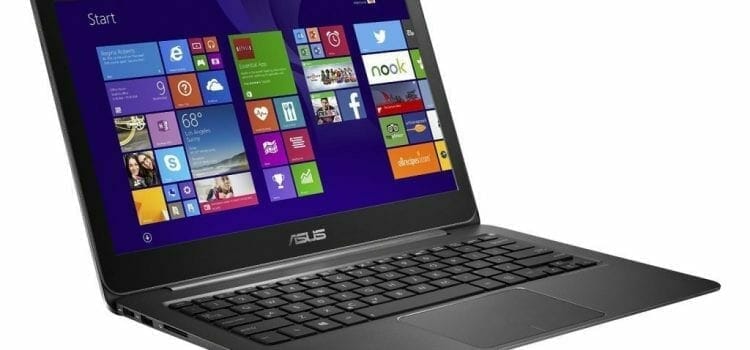The ASUS Zenbook UX305FA-ASM1 is the newest midrange ultraportable from Asus, and boy is it slim. Thin and light have been the watchwords in the industry, especially for new laptops, smartphones, tablets and iPads for years now. Asus made major compromises to get the Zenbook to its svelte proportions: they leave the new system looking less impressive than its competitors like the Editor’s Choice Apple MacBook Pro with M1 processor.
Asus has always prioritized the design of its Zenbook line, and the Asus ZenBook UX305FA doesn’t fall far away from the pack. Here you get a slim chassis etched with a pattern of concentric circles, and the finish has a near-black color that Asus calls “obsidian stone.” The design cries out for attention and is quite compelling for anybody interested in the looks. Is it really worth the competition apart from the thin and light chassis, lets find out!
Design
Yes, here we are talking of a really thin and slim ultraportable laptop. The slim aluminium frame measures 8.9 by 12.8 by 0.5 inches (HWD), and weighs just 2.6 pounds. That’s roughly the same size and weight as the Lenovo Yoga 3 Pro, and is lighter than the Dell XPS 13 Touch(2.76 pounds) and even than the Apple MacBook Air (2.91 pounds). The ubersvelte design also invites comparisons to one other prominent Apple product, the 12-inch Apple MacBook—the Zenbook UX305FA-ASM1 measures 0.5-inch thick versus the MacBook’s 0.51-inch—but the MacBook is lighter by 0.6-pound.
That’s not a lot of a difference, but it’s one of the reasons Apple charges nearly twice as much for what is an otherwise very similar laptop. In graphics tests, the limits of the Core M platform really start to show, as the integrated Intel HD Graphics 5300 solution can handle basic tasks, like Web browsing and streaming media, but more intensive uses, like gaming, are beyond its capability.

The display looks great, with a full HD (1,920-by-1,080) resolution and an In-Plane Switching (IPS) panel that offers wide viewing angles and good color. An anti-glare finish keeps the reflections to a minimum, though it does slightly dull the blacks shown on screen. Most notably, the display does not have touch capability, an omission that may limit its appeal to users who want to make the most of the touch-friendly Windows 8.1 interface and gesture controls.
The chiclet-style keyboard feels nice to type on—equivalent to past Asus Zenbooks, at least—but there is no backlight, which will be a bit of pain if you need to type something when the lights are lowered for a PowerPoint presentation. The accompanying touchpad is relatively large, measuring 4.1 by 2.9 inches, with a wide, clickable surface.
Performance
The ASUS Zenbook UX305FA runs on Intel Core M processor; which ideally sit between the mainstream Intel Core i3 and Core i5 CPUs and the low-powered Intel Atom and Celeron chips used in many budget-friendly laptops. It finds the middle ground between both ends of the spectrum by offering better performance than the low-powered chips, but with lower power demands than the standard Intel Core CPUs.
The result is a better mobile processing experience that maximizes battery life while keeping performance up in an acceptable, though unexceptional, range. This puts the machine ahead of the Core-M-equipped Lenovo Yoga 3 Pro, but it falls a bit behind non-Core-M laptops, like the Dell XPS 13 Touch and the Acer Aspire S7-392-5410.
Despite the slim dimensions of the chassis, Asus outfits the Zenbook with a full complement of ports and connectors. On the right is a USB 3.0 port with USB Charger+, a sleep-and-charge solution that offers faster charging for smartphones and tablets. An HDMI Type D (micro) port offers video and audio output, while a headset jack supports headphones and a mic. On the left are two more USB 3.0 ports, along with an SD card reader.
The laptop is also equipped with dual-band 802.11n Wi-Fi and Bluetooth 4.0 for wireless connectivity. For storage, there’s a 256GB solid-state drive (SSD). That’s twice the standard capacity of the Apple MacBook Air 13-inch or the MacBook Pro 13-inch, (both of which come standard with 128GB drives), but it’s on par with rest of the competition, like the Lenovo Yoga 3 Pro and the Dell XPS 13 Touch, both of which come with 256GB drives.
Asus offers some extras for security as well, with an embedded Trusted Platform Module (TPM) chip, LoJack and Intel Anti-Theft technology, and a built-in case-lock slot to physically secure the laptop. Asus covers the Zenbook UX305FA with a one-year warranty that also includes protection against accidental damage from drops, spills and electrical surges, which most manufacturer warranties don’t include.
Summary
The ASUS Zenbook UX305FA-ASM1 may be extremely thin and feather-light, but an ultraportable laptop can’t get by on those aspects alone. Even when stacked up against systems that are similarly slim, the Asus Zenbook UX305FA falls short, due in large part to its Intel Core M processor. That’s a difference that outweighs svelte design, so the Apple MacBook Pro remains our top pick for midrange ultraportables.
